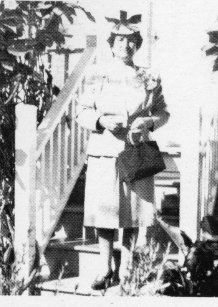Santa Rosalia: the Saint, the Festival, and Monterey's Sicilian Fisherman
 Santa
Rosalia is the adopted patron saint of Monterey’s Sicilian
fisherman. Each year, in the fall, the statue of Santa Rosalia is
removed from its pedestal in the old San Carlos Church and paraded to
the water front for the blessing of the fleet. This tradition began
with the original Isola delle Femmine immigrants and continues to
this day.
Santa
Rosalia is the adopted patron saint of Monterey’s Sicilian
fisherman. Each year, in the fall, the statue of Santa Rosalia is
removed from its pedestal in the old San Carlos Church and paraded to
the water front for the blessing of the fleet. This tradition began
with the original Isola delle Femmine immigrants and continues to
this day.
Who was Santa Rosalia?
Rosalia (1130-1166) was the daughter Count Sinibaldo della Quisquina. As a young woman, Rosalia abandoned her family’s comfortable lifestyle and retreated to a cavern on Monte Pelligrino. Here she lived as a hermit dedicating her life to prayer.
According to
tradition, a ship from North Africa carrying the bubonic plague
landed in Palermo on May 7, 1624. The epidemic that ensued
caused the deaths of about one third
 of Palermo's populace. The epidemic raged on until the middle
of July when a young man, Matteo Bonello, had a vision in which
Rosalia appeared to him and directed him to her cave. She
instructed him to retrieve her bones and to carry them to the four
corners of the city. Bonello found the cave, Rosalia's bones and a
rock with Rosalia's name on it. He carried the bones to the
city and Palermo's horrible plague was over.
of Palermo's populace. The epidemic raged on until the middle
of July when a young man, Matteo Bonello, had a vision in which
Rosalia appeared to him and directed him to her cave. She
instructed him to retrieve her bones and to carry them to the four
corners of the city. Bonello found the cave, Rosalia's bones and a
rock with Rosalia's name on it. He carried the bones to the
city and Palermo's horrible plague was over.
Santa Rosalia and the City of Palermo
Santa Rosalia became the patron saint of the City of Palermo. In fact, she is generally revered throughout Sicily. Every July 15-17, Palermo holds a festival to commemorate the ending of the plague and to honor their patron saint. The annual festivities are elaborate and attract people from great distances. The Commune of Isola delle Femmine is a mere 15 kilometers from Palermo. No doubt, many of the original Isola delle Femmine immigrants participated in Palermo’s annual revelry.
Origins of Monterey’s Santa Rosalia Festival
Monterey’s
Santa Rosalia Festival was the brainchild of Francesca (Ferranti)
Giamona (pictured below left).
 Perhaps
recalling childhood memories of the Palermo Festival, or because of
the affinity most Sicilians have for Santa Rosalia, she recruited the
help of Giovanna Balbo, Rosa Ferrante and Domenica Enea. With
financing from Francesca’s uncle, Pietro "Pete"
Ferranti, the four women launched the first tribute to Santa Rosalia
and the blessing of the fleet.
Perhaps
recalling childhood memories of the Palermo Festival, or because of
the affinity most Sicilians have for Santa Rosalia, she recruited the
help of Giovanna Balbo, Rosa Ferrante and Domenica Enea. With
financing from Francesca’s uncle, Pietro "Pete"
Ferranti, the four women launched the first tribute to Santa Rosalia
and the blessing of the fleet.
The early Festivals consisted primarily of an elaborate procession from the church to the wharf. The procession was usually led by young girls dressed in white to represent angels. Following the "angels" was an Italian-style band usually from the Italian Catholic Federation in Pittsburg. Behind the band came the fishermen carrying the statue of Santa Rosalia on their shoulders, and later on a float. And, finally, came the congregation and the community. This group was usually led by the older women of the community dressed in traditional Sicilian black singing hymns.
Over the years, the Festival has taken many forms. At times referred to as the Fisherman's Festival and other times the Santa Rosalia Festival, the festivities have included parades, dances, outdoor Masses, and festival queens. But, no matter what else may have been included, the Festival has always concluded with the procession to the water front and the blessing of the fleet.
